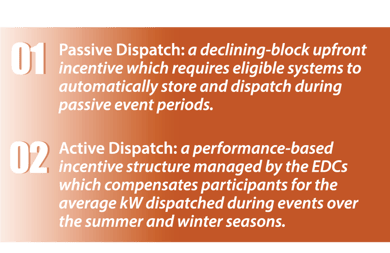- Home
- Services
- Hi-Line Engineering
- About
- Careers
- Contact
- Requests For Proposals
Dispatchable storage gains momentum in the east
by GDS Associates, Inc | May 3, 2022 | Energy Use & Efficiency , Newsletter - TransActions
 Distributed energy resources (“DERs”) are generally defined as small-scale generation and battery storage systems that are installed at utility retail customers’ homes and businesses. There is a growing trend to aggregate DERs to provide significant benefits to the utility grid in times of constrained capacity or outages. DERs often consist of a renewable generation source in tandem with battery energy storage and electric utilities across the world are increasingly interested in the economic and resiliency benefits of aggregating these customer sited systems into dispatchable resources. While the concept of moving these DER assets into a single dispatchable resource is not new, the complex coordination of the various components has become an easier reality for many utilities in recent years due to technology and communication advancements. Many utilities have turned to deployment of Distributed Energy Resource Management Systems or “DERMS”, as a solution to handle the multitude of variables that must be accounted for in utilization of the DER assets.
Distributed energy resources (“DERs”) are generally defined as small-scale generation and battery storage systems that are installed at utility retail customers’ homes and businesses. There is a growing trend to aggregate DERs to provide significant benefits to the utility grid in times of constrained capacity or outages. DERs often consist of a renewable generation source in tandem with battery energy storage and electric utilities across the world are increasingly interested in the economic and resiliency benefits of aggregating these customer sited systems into dispatchable resources. While the concept of moving these DER assets into a single dispatchable resource is not new, the complex coordination of the various components has become an easier reality for many utilities in recent years due to technology and communication advancements. Many utilities have turned to deployment of Distributed Energy Resource Management Systems or “DERMS”, as a solution to handle the multitude of variables that must be accounted for in utilization of the DER assets.
DERMS has a number of industry leaders in the electric utility and manufacturing / software vendor space, resulting in a number of encouraging but exploratory implementations that is paving the way for the future of utility grid operation. In Connecticut, the Public Utilities Regulatory Authority (“PURA”) took an aggressive approach to promoting DERMS throughout the state by putting forth an order for the electric utilities (aka, Eversource and United Illuminating (“UI”)), to develop and implement a program for battery energy storage systems. These battery energy storage systems will be connected to the electric distribution system and would provide multiple types of benefits to the grid, including ancillary services, peak shaving, support for the deployment of other distributed energy resources, and additional grid resiliency. The Eversource and UI program consists of two key incentive offerings: 
The PURA order further defines specific customer categories that will be allowed to compete in the New England Independent System Operator (“ISO”) market in addition to qualifying for dispatch incentives based on their status as a: 1) Grid-edge customer, 2) Critical facility, 3) Owners of fossil-fueled generators, or 4) Small Business customers. In this program, the electric utility has responsibility over the DERMS product and serves a critical role in the relationship with the retail customer’s assets and relationship with the ISO. The customers receive installation and performance incentives for both active and passive dispatch, all aggregated through the DERMS platform. The program was developed over the past two years as part of PURA’s broader effort to modernize the electric grid, and is the final product of the coordinated efforts between utilities, vendors, stakeholders, and consultants. It also follows the Connecticut legislature’s passage of a law last year establishing a statewide goal of deploying 1,000 megawatts of energy storage by 2030.
In DER deployment heavy states like California where there is combination of higher electric rates, demand charges, and the Self-Generation Incentive Program (SGIP), the economics can be more attractive for homeowners and businesses to engage in generation to serve peak load reduction and resiliency. The SGIP program, known as one of the more advanced self-generation incentive programs in the country, provides a range of long-term performance
incentives for both renewable and renewable with storage projects. Incentive rates for reimbursement of renewable generation are $2.00/watt as of 2021, as one example, but when designed as a resiliency focused renewable project, that incentive can move to $4.50/watt. With recent actions by utilities, such as Southern California Edison and Pacific Gas & Electric, to implement Public Safety Power Shutdowns (PSPS’s), the purposes and economics for storage systems were quickly expanded in the SGIP program to improve resiliency capabilities. One common theme that developed quickly in the SGIP programs is a pattern of affluent early adopters for residential storage, including medical facilities and assisted living / long-term care residences. In these cases, the value proposition is not about the cost of the energy being displaced, but about the value that the energy has for the lives of the end-users. This dual benefit also exists in the aforementioned Connecticut program, allowing for financial and resiliency benefits to the retail customers.
Building a network of battery storage systems that need to
respond relatively quickly to signals from the DERMS provider requires a reliable and swift communication pathway. Currently, Tesla is the only battery manufacturer that consistently provides real-time, 15-minute interval data. All other battery partners provide interval data via periodic uploads to hosted SFTP sites or other data sharing platforms. In most cases, battery partners provide these data files in one bulk upload at the conclusion of the battery demand response season to enable Measurement and Verification (“M&V”) calculations. This lag can be problematic in terms of the feedback loop between the customer site and the program operators, but the dispatch signals sent to the systems are uninhibited by this delay. Still, discussions are underway with manufacturers to better understand the limitations to system modification and improve the data communication timeline (e.g, bi-weekly or weekly) for sending back interval data.
As the adoption of individual DER systems grows, the coordination can become cumbersome without unified direction. Furthermore, electric utilities in the United States have become the focus of discussion around centralization and FERC’s Order 2222 allows DER systems to be accepted as capacity resources in wholesale markets. In this specific order, the aggregation of DERs is the goal and regional electric operators (i.e. regional transmission operators) must coordinate to accommodate the industry’s move to utilize DER assets as generation resources. Along with this increased coordination comes the complexity of utility incentives that can be upstream for installation cost reduction or dispatchable performance incentives paid at the kW level, or both.
It is expected that the electric utility is going to be a central
player in DERs and customer sited dispatchable storage processes, which requires the electric utility to invest in planning efforts and dedicated personnel to manage the DER systems on their grid. Lessons learned from implementation and program evaluation are going to be critical as the deployment of these systems spreads across the country – this will be accelerated with falling equipment prices and State regulators’ motivation to electrify and incentivize electric utilities to be more nimble and increase grid resiliency.
As the sharing of DER ideas and success stories continues in industry conferences, white papers, and formal reports, the barriers to entry will be reduced for smaller utilities or utilities with very dynamic peaks that have been eager to participate in this style of DER implementation. What lies beneath the complex nature of a dispatchable DER grid is a reliable and resourceful American energy grid.
For more information or to comment on
this article, please contact:  Josh Duckwall, Senior Project Manager
Josh Duckwall, Senior Project Manager
GDS Associates, Inc. - Marietta, GA
770-799-2437
josh.duckwall@gdsassociates.com
References:
1 California Public Utilities Commission. (2022). Self-generation incentive program. March 30, 2022.
2 Federal Energy Regulatory Commission. (2020). Fact Sheet: FERC order no. 2222: A new day for distributed energy resources.
GET OUR NEWSLETTER
RECENT POSTS
Archives
- December 2015 (8)
- June 2025 (7)
- January 2016 (6)
- July 2016 (6)
- March 2021 (6)
- May 2022 (6)
- August 2020 (5)
- March 2015 (4)
- January 2019 (4)
- June 2019 (4)
- August 2019 (4)
- February 2020 (4)
- May 2020 (4)
- June 2020 (4)
- December 2020 (4)
- July 2021 (4)
- October 2021 (4)
- April 2024 (4)
- December 2024 (4)
- May 2025 (4)
- April 2015 (3)
- August 2016 (3)
- February 2017 (3)
- July 2017 (3)
- February 2018 (3)
- February 2019 (3)
- November 2019 (3)
- March 2020 (3)
- April 2020 (3)
- September 2021 (3)
- December 2021 (3)
- August 2022 (3)
- December 2022 (3)
- April 2023 (3)
- July 2023 (3)
- December 2023 (3)
- September 2024 (3)
- October 2025 (3)
- May 2014 (2)
- February 2016 (2)
- March 2016 (2)
- September 2016 (2)
- November 2016 (2)
- January 2017 (2)
- July 2018 (2)
- November 2018 (2)
- March 2019 (2)
- May 2019 (2)
- July 2020 (2)
- September 2020 (2)
- April 2021 (2)
- August 2021 (2)
- October 2024 (2)
- September 2025 (2)
- February 2014 (1)
- April 2014 (1)
- July 2014 (1)
- August 2014 (1)
- November 2014 (1)
- February 2015 (1)
- May 2015 (1)
- June 2015 (1)
- November 2015 (1)
- October 2016 (1)
- December 2016 (1)
- October 2018 (1)
- December 2018 (1)
- April 2019 (1)
- July 2019 (1)
- September 2019 (1)
- October 2020 (1)
- November 2020 (1)
- February 2021 (1)
- April 2022 (1)
- July 2022 (1)
- October 2022 (1)
- August 2023 (1)
- October 2023 (1)
- July 2025 (1)
- November 2025 (1)
- December 2025 (1)
Categories
- Newsletter - TransActions (85)
- News (78)
- Employee Spotlight (35)
- Energy Use & Efficiency (28)
- Energy, Reliability, and Security (15)
- Other Specialized Services (11)
- Environment & Safety (10)
- Power Supply (8)
- Transmission (8)
- NERC (7)
- Utility Rates (7)
- Cyber Security (5)
- Energy Supply (4)
- Hi-Line: Utility Distribution Services (4)
- Battery Energy Storage (3)
- Uncategorized (2)
- Agriculture (1)
- Hi-Line: Seminars & Testing (1)